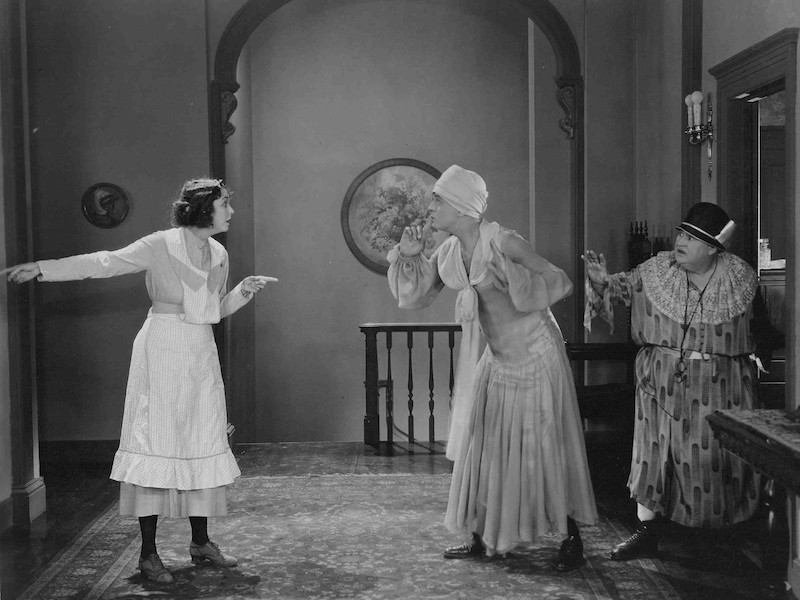WHAT HAPPENED TO JONES
William A. Seiter (US 1926)
Score: Juri Dal Dan
Performed live by: Zerorchestra
Conductor: Juri Dal Dan
George Broadhurst’s 1897 stage farce What Happened to Jones was first filmed in 1915 by World and again by Famous Players-Lasky in 1920 before Universal acquired the property for Denny in 1925. Reg was pleased to be working steadily with easy-going Bill Seiter, now reteamed for their third film together. Seiter concurred with Reg’s approach to comedy in that he felt slapstick didn’t fit the British stage actor’s personality, so he didn’t push the hokum. Although the studio executives wanted Reg to play the Jones character with over-the-top broad comedy, the actor and director agreed they were going to do it their way and have little clowning. The story was silly enough already, and Reg played it naturally, where it was believable. As can clearly be seen on screen, the crew had a blast making this hilarious comedy.
Things kick off to a brisk start when Tom Jones (Denny) is stampeded into a poker party on the night before his wedding to Lucille Bigbee (Marian Nixon, in the third of six films the two stars made together). The gathering is raided by the police, and the poker players battle the cops and escape. Jones and Ebenezer Goodly (Otis Harlan, in the third of eight films with Denny) go down a fire escape and enter the open window of a “Reducing Parlor” where many scantily clad stout women are roaming the halls. The fugitives dodge from one section to another, finally hiding in an “electric light bath cabinet,” their protruding heads covered with towels. They pass for women as the police search the place, but when an attendant turns on more heat, Jones disrobes inside the cabinet to avoid suffocation. Jones and Goodly escape naked to the dressing rooms, where they don women’s clothing and exit the parlor. It’s one comical scenario after another on the city streets until Jones, eventually disguised as a bishop, reaches the church where he is to marry his waiting fiancée.
What Happened to Jones was hailed as a “Laugh-Riot” on release, with some claiming it was one of the funniest pictures ever seen on Broadway. Los Angeles Times columnist Grace Kingsley enthused, “The greatest comedy success of the current season is Reginald Denny in What Happened to Jones. Guffaws, not giggles, accompany its showing this week… If you don’t laugh until you cry…you will be different from the gang including myself which yesterday simply howled with laughter all through the comedy’s unrolling. If other comedians don’t watch out, Denny is going to tear the laurels from all their brows. His comedy gifts are being cultivated. But especially he has a tremendously likable personality. That wide crooked grin of his is a fortune in itself.” The Kansas City Times reported that the film “indicates why Universal Pictures Corporation is holding the comedy star against the attractive offers of Paramount and other rival producers. Denny has created an unusual following and each succeeding picture seems to be an improvement over its predecessor.”
Glowing reviews must have helped soothe frazzled studio nerves from the week prior to release, when Reg took pals Ben Hendricks Jr. and “Hub” Lloyd out on his yacht the S.S. Barbarene for a day of marlin fishing from San Diego. They were headed toward Ensenada when a violent storm blew in, taking the craft out to sea. Reg, Hendricks, and Lloyd feared the yacht would capsize in the twenty-foot waves and they worked hard to gain whatever control they could. When Reg and Hendricks didn’t show up on set the following day, the studio was less concerned about What Happened to Jones, and more with what happened to Reg. Carl Laemmle hired two pilots to fly search planes from Santa Monica’s Clover Field over the Pacific, and the U.S. Coast Guard sent out military boats from San Diego in an ocean rescue effort to find Reg and his lost companions. After three days without communication, Reg finally navigated his way to San Diego harbor and called Laemmle to let everyone know they were alive. The studio wasn’t happy about their star’s reckless behavior; however, record-breaking audiences for the newest Denny release must have been sweet recompense.
Kimberly Pucci


regia/dir: William A. Seiter.
scen: Melville W. Brown, dalla pièce di/based on the play by George Broadhurst (1897, New York).
photog: Arthur Todd.
mont/ed: John Rawlins.
scg/des: Leo E. Kuter.
asst dir: Nate Watt.
cast: Reginald Denny (Tom Jones), Marion [Marian] Nixon (Lucille Bigbee), Otis Harlan (Ebenezer Goodly), Zazu [ZaSu] Pitts (Hilda), Emily Fitzroy (Mrs. Goodly), Margaret Quimby (Marjorie Goodly), Melbourne MacDowell (Mr. Bigbee), Francis [Frances] Raymond (Mrs. Bigbee), Ben Hendricks [Jr.] (Richard Heatherly), Nina Romano (Alice Starlight), William Austin (Henry Fuller), John Elliott (il vescovo/The Bishop), Edward Cecil (Smith), Broderick O’Farrell (Rector).
prod: Carl Laemmle, Universal-Jewel.
dist: Universal.
uscita/rel: 31.01.1926 (copyright 09.12.1925).
copia/copy: DCP, 70’46”, col. (orig. 35mm, 6726 ft.,imbibito/tinted); did./titles: ENG.
fonte/source: Universal Studios.




